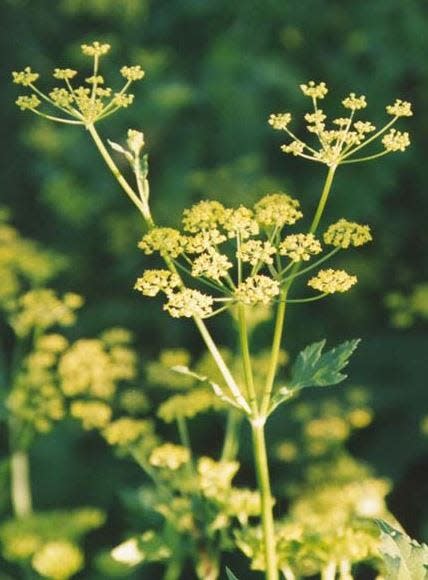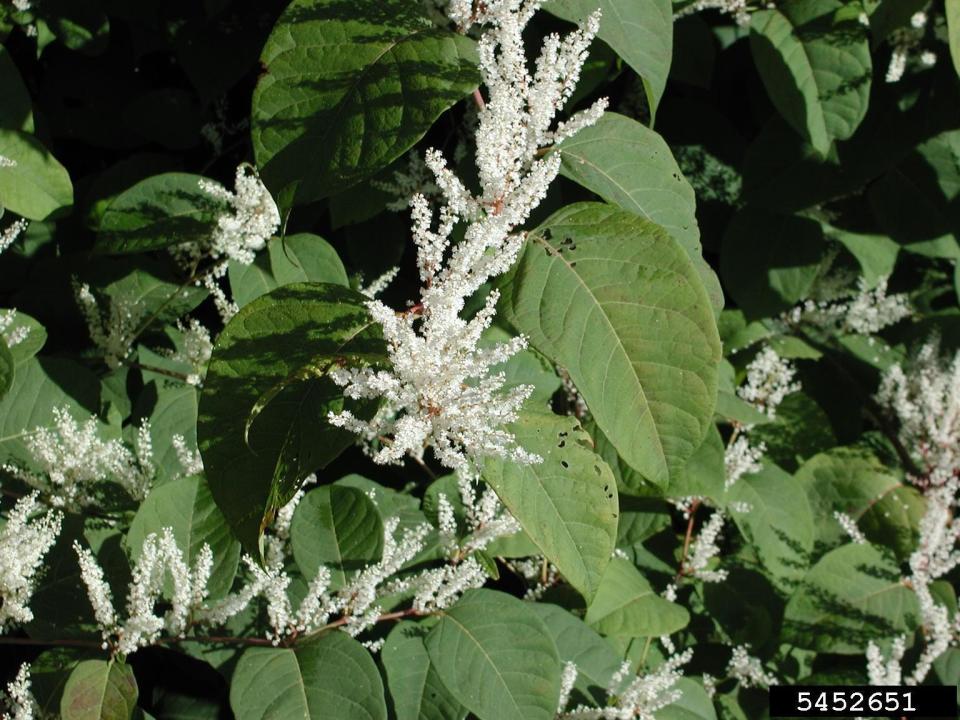Dense thorn bushes, 2-foot-wide flowers and more. These are Wisconsin's worst invasive plants.
There are nearly 150 species of invasive plants in Wisconsin, causing damage to the economy, ecosystems and human health in the state, according to the Invasive Plants Association of Wisconsin.
Mary Bartkowiak, forest health and invasive plant program coordinator at the Wisconsin Department of Natural Resources, told us about six of the most problematic ones.
Here are the plants you should watch out for and what to do if you happen upon them.
Common buckthorn spreads rapidly and hinders the growth of other plants
Common buckthorn is one of Wisconsin's most prevalent invasive plant species. This tall shrub causes multiple ecological problems due to its chemical makeup and the dense shade it casts.
Buckthorn is popular among gardeners as a natural fence or barrier, Bartkowiak said. It's ideal for that job because it grows very dense and is very resilient. However, these traits also make it difficult for other plants to grow in areas where buckthorn is present. The dense invasive plant causes overcrowding and low light levels, which cause tree seedlings and understory species to be unable to regenerate, the DNR says.
Additionally, buckthorn leaves contain high levels of calcium and nitrogen, causing them to decompose quickly. When these decomposing leaves fall on the forest floor, this attracts non-native earthworms, which eat the leaf litter and quickly release the nutrients from it into the soil, Bartkowiak explained. But because our native plants and trees evolved without the presence of earthworms, this quick release of nutrients causes them to suffer because they require a much more gradual release of nutrients.
The DNR recommends the removal of invasive buckthorn. This guide by the University of Wisconsin-Extension explains a number of buckthorn removal strategies.
Japanese barberry attracts Lyme disease-carrying pests
Japanese barberry is a compact, thorny shrub native to Japan that came to the U.S. through the horticulture industry. This invasive species poses threatens to both forest ecosystems and human health.
Japanese barberry has very dense thorns and produces lots of berries, which birds eat, spreading the plant and often causing large infestations in wooded areas, Bartkowiak said.
Japanese barberry forms dense thickets, which limit the amount of light reaching the forest floor and impact forest regeneration, according to the DNR. The plant actually grows so dense that it changes light and humidity levels, Bartkowiak said. Additionally, the plant's thorns, which scratch people and stick to clothing, make it difficult to remove.
Barberry also provides a good place for white-footed deer mice to hide from predators. These mice often carry and spread Lyme disease. Bartkowiak said research has indicated that forests infested with large Japanese barberry populations also have a higher occurrence of Lyme disease. She recommends that anyone who has barberry as part of their landscaping have it removed unless the plant is proven to be sterile.

Garlic mustard negatively impacts native plant growth by hurting symbiotic root-fungi relationships
Garlic mustard is an invasive herb species that people often plant in their gardens and use for salads and seasonings. The species, which is native to Europe and Asia, produces lots of seeds and is very adaptable, Bartkowiak said. Therefore, it can spread out of people's gardens and into native ecosystems where it poses a threat to biodiversity.
Garlic mustard is an allelopathic plant, meaning it produces chemicals that keep other plant species from growing and thriving nearby. However, Bartkowiak said, garlic mustard's allelopathy doesn't just keep other plants away, it also impacts the mycorrhizae ― the mutually beneficial relationship between native plants and the fungi in their root systems.
Even a few years after garlic mustard has been removed from an area, it still impacts the mycorrhizae, Bartkowiak said. Garlic mustard's effect on the mycorrhizae makes it more difficult for native plants to grow and reduces their health and vigor.
According to UW-Extension, small infestations of garlic mustard can be hand-pulled, however, you should not compost pulled plants because most compost piles don't get hot enough to kill the seeds. Pulled plants should be buried deep in an area that will not be disturbed or should be burnt while moist. Burning dried garlic mustard can spread its seeds.
For more information about removing and disposing of garlic mustard, visit the UW-Extension Horticulture website.

Wild parsnip sap causes skin rashes and blistering
Wild parsnip is an invasive member of the carrot family, often found along highways, in prairies or bordering farm fields, UW-Extension says. The plant is 4-to-5-feet tall and has bright, yellowish-green flowers.
Wild parsnip spreads rapidly in sunny areas, and an infestation is difficult to control once it's established. It generally doesn't tolerate shade very well, but Bartkowiak said some populations have moved into the North Woods, showing that the plant can evolve to tolerate a range of ecotypes.
Wild parsnip is problematic because the plant's sap can cause phytophotodermatitis ― a type of skin rash or blistering that occurs when skin exposed to the plant's sap is then exposed to sunlight. The rash typically occurs 24-to-48 hours after exposure and feels similar to a sunburn, according to UW-Extension. Rashes caused by wild parsnip can leave brown scars that can last for multiple years.
The best way to control wild parsnip is by safely removing it ― wearing long sleeves, pants and gloves ― as soon as you find some on your property. Information on how to safely remove small and large wild parsnip infestations can be found here on the UW-Extension website.
Giant hogweed can permanently damage human skin
Often growing over 8-feet tall with leaves up to 5-feet wide and 2-foot-wide flowers, the giant hogweed certainly lives up to its name. The plant's large, white flowers are called "umbels" because of their umbrella-like appearance.
However, although giant hogweed may be a cool sight to behold, touching the plant can be very damaging to human health. Like the wild parsnip, giant hogweed contains sap that can cause a skin reaction when exposed to the sun. Touching the sap to your eyes could cause temporary or permanent blindness, the DNR says.
Giant hogweed is considerably rarer than the other invasive plants on this list, but it is classified statewide as "prohibited" by the DNR. This means that it cannot be possessed, transported or introduced in Wisconsin without a permit.
More information on giant hogweed and preventing the spread can be found on the DNR website.

Three invasive knotweed species can burst through asphalt, destroying infrastructure
Three closely related invasive knotweed species ― the Japanese, Bohemian and Giant knotweeds ― are serious threats to Wisconsin's waterways, where their thick, bamboo-like stems prevent streamside tree regeneration and increase shoreline soil erosion, according to the DNR.
Knotweed stems are so strong, the DNR says a machete or similar tool is needed to cut through them. This means, once knotweed is present at a stream or a river, it is nearly impossible for fishermen, boaters and canoers to use or enjoy the space. The erosion caused by knotweed also drives off fish and wildlife.
Knotweeds are very strong and resilient. Root fragments as small as a couple of inches can resprout and produce new infestations, the DNR states. The plant is also difficult to control because its roots can grow as deep as 9 feet, and horizontal roots can push their way under streets and up through pavement and asphalt, causing damage to infrastructure, Bartkowiak said. In an example cited by the DNR, one business in the United Kingdom had to spend over $600,000 to replace its parking lot after extensive damage caused by Japanese knotweed.
For more information about knotweed, identifying the plant and strategies for removing and controlling it, check out this factsheet by the DNR.
This article originally appeared on Milwaukee Journal Sentinel: What are the worst invasive plant species in Wisconsin?

